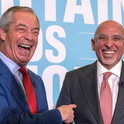Every general election presents the Liberal Democrats with a challenge. How should they position themselves against Labour and the Conservatives? Over the years they have tried a variety of tactics. A glance back at them helps us to understand the way Jo Swinson is wrestling with that question today.
In February 1974, the Liberals argued that they were Britain’s only radical party. They asked of their two rivals: “Which twin is the Tory?” Their vote more than doubled to 19 per cent, but they won only 14 seats.
In 1983, the Liberal/Social Democratic Party Alliance sought to “break the mould” of British politics by replacing Labour as Britain’s main progressive party. They came close in votes (Labour 28 per cent, Alliance 26 per cent), but Labour still won almost ten times as many seats (209 versus 23).
In terms of seats gained, the Lib Dems’ most successful election by far was 1997. They jumped from 20 MPs to 46—the largest third-party number since 1929. Actually, the party’s vote share slipped slightly, from 18 to 17 per cent; but tactical voting by Labour supporters helped Lib Dem candidates defeat more than two dozen incumbent Tories. It helped that Paddy Ashdown, the Lib Dem leader, abandoned the party’s policy of equidistance between Labour and the Conservatives, and moved closer to Tony Blair and New Labour.
There is one obvious example of the Lib Dems co-operating with the Tories—after the 2010 election. Nick Clegg’s party paid the price: it lost 49 of its 57 seats.
Today, Swinson finds it far easier to say what she doesn’t want than what she does. She hates Boris Johnson’s Brexit, and Jeremy Corbyn’s far left prospectus. She says she wants to be prime minister; but she knows that this is nonsense. Corbyn is more likely to become Chief Rabbi.
More relevantly, she says that if we end up with another hung parliament, she won’t prop up either Johnson or Corbyn. This leads to the obvious follow-up point: since one of them is almost certain to be prime minister after the election, she really should tell her voters what she would do.
Here is my suggestion. It is not to change her stance but to make it more credible.
Swinson’s starting point should be to acknowledge that, in a hung parliament, the initiative will not lie with her. Either Johnson will try to soldier on without a majority or he will step down. If he tries to stay in Downing Street, Ed Davey, Swinson’s deputy, has told Andrew Neil on his BBC show that the Lib Dems might be up for discussions with Johnson on a new Brexit referendum. I doubt Johnson would agree—too many of his MPs hate the idea—but it would not be crazy for the Lib Dems to make the offer.
What, though, if Johnson decides that there are too few Tory MPs for him to carry on? He will then resign, and the Queen will invite Corbyn to try to form a government. The assumption that pretty well everyone makes in discussing what happens next is that the Tories, who will almost certainly still be by far the largest party in the new House of Commons, will oppose Corbyn’s Queen’s Speech. The decision of the Lib Dems to vote for Corbyn, or against him, or abstain, could be vital to what kind of government, if any, Britain has at the start of 2020.
Is that assumption correct? Twice in the past century, a Conservative prime minister has resigned following an inconclusive election. In January 1924 Stanley Baldwin made way for Ramsay MacDonald, even though the Tories had 67 more MPs than Labour. In March 1974, Edward Heath resigned after failing to do a deal with the Liberals, and Harold Wilson returned to office.
The key point is this. On both occasions, the Conservatives did not try to stop Labour governing. They voted against specific measures, but not to bring the new government down. Their reason was that, having acknowledged that they could not carry on, they would risk a huge public backlash should they seek to prolong political deadlock and intensify a great national crisis.
The same logic would apply this time. Indeed, one could go further. Neither Baldwin nor Heath faced an immediate challenge to their party leadership. In contrast, Johnson, having lost his election, would face a Conservative Party in turmoil. It is likely to retreat in order to sort out—fight over—its own future.
In practice, then, Swinson would not have to decide what to do. Corbyn would survive as prime minister thanks not to the Lib Dems or SNP but to the Conservatives. However, he would be a prime minister without the power to do anything much, apart from sort out Brexit and legislate for a new referendum. Parliament wouldn’t turf him out—but nor would it vote for any of his more radical policies. He would probably get through a modestly expansionary budget, with more for health, schools, welfare, police etc—but not much more than the Tories have promised. But rail nationalisation? Free monopoly state broadband? Workers on boards? Big jump in corporation and income taxes? Forget them.
So Swinson should not tie herself in knots fretting over the Johnson-or-Corbyn question, for she will have no real power to answer it. Instead, should simply say: a) “my MPs will oppose both a hard Brexit and a vast increase in the power of the state”; and b) “in a hung parliament, the more Lib Dem MPs there are, the more certain it is that we can, with other MPs, block either form of madness.”
Sorted. Pleased to help.
What everyone has missed about the position of the Liberal Democrats
The debate over Jo Swinson’s tactics relies on an assumption that is incorrect
November 22, 2019

Back Johnson or Corbyn? That's not necessarily the right question. Photo: Aaron Chown/PA Wire/PA Images












